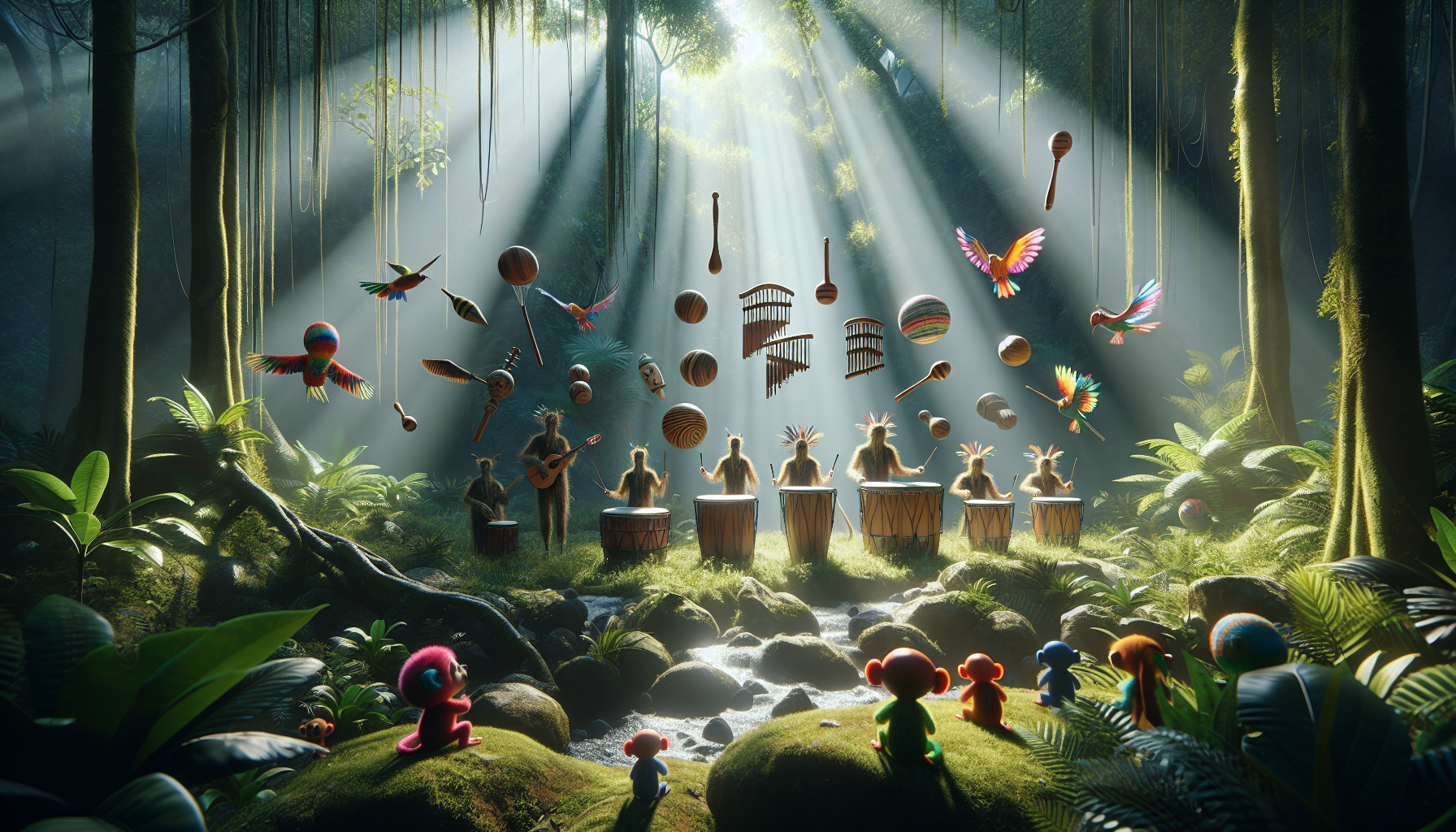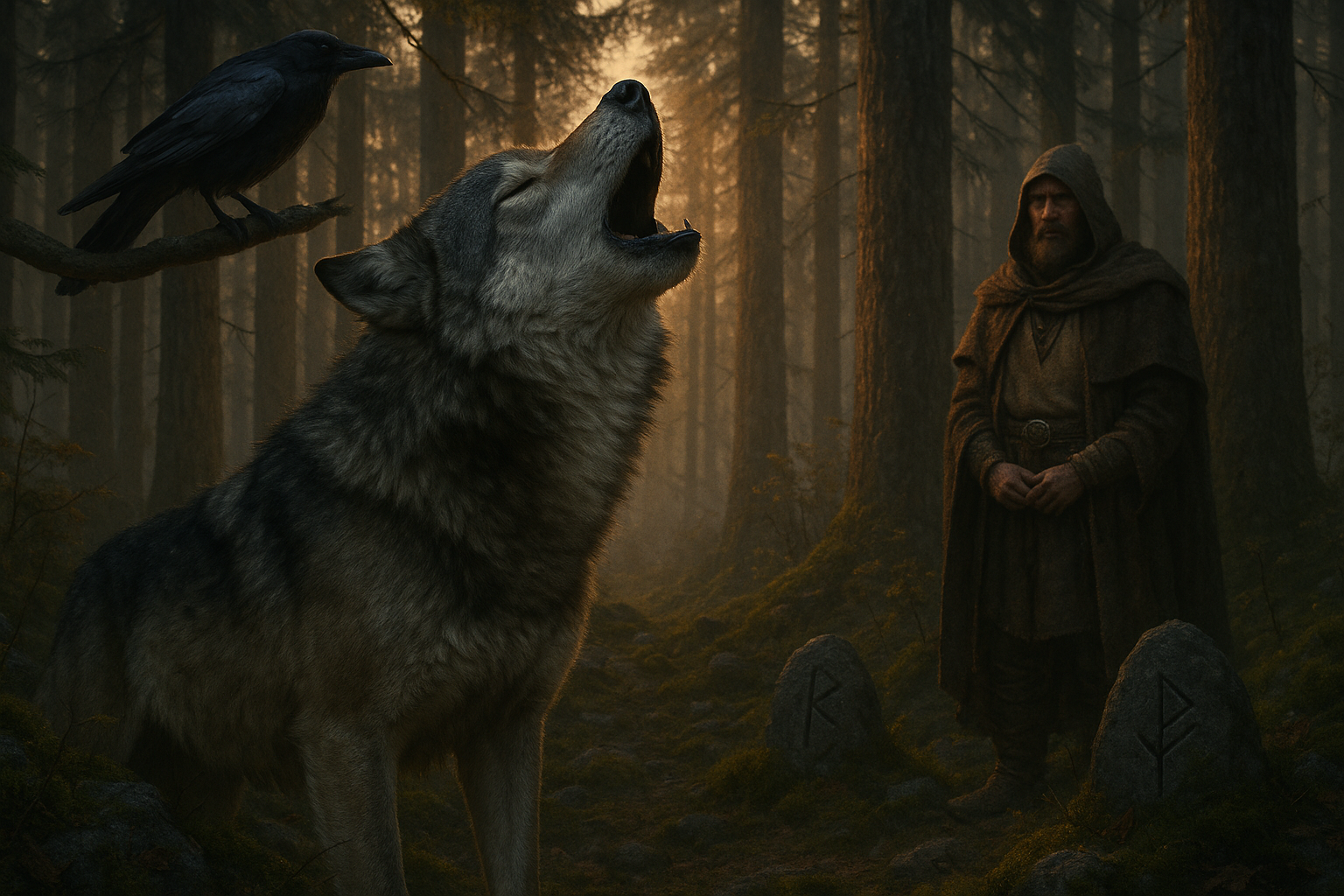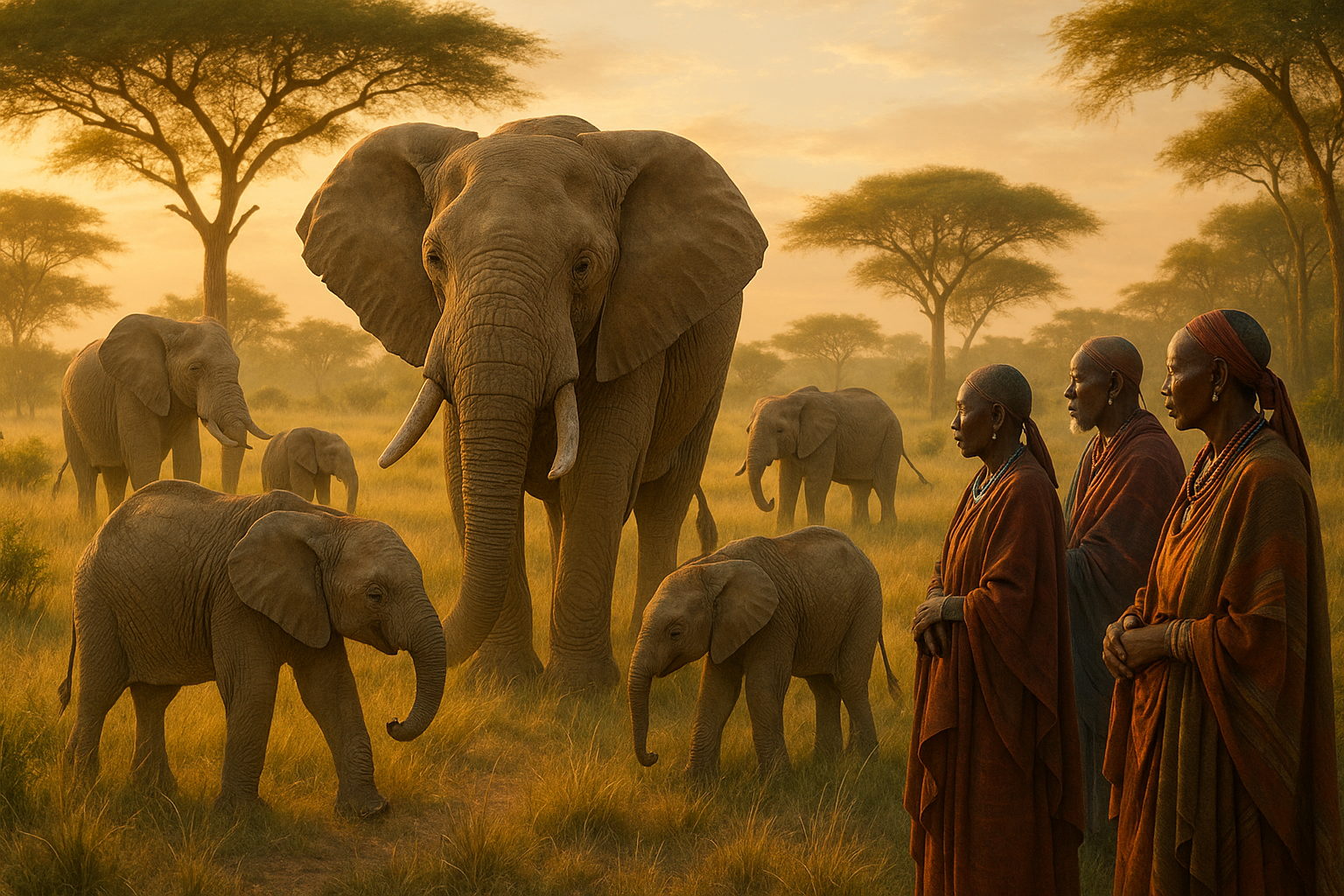In the heart of the world’s most lush and impenetrable forests, where the canopy above forms a verdant tapestry filtering the sunlight into a soft, mystical glow, there exists a symphony unlike any other. It’s a performance that defies the traditional stages and concert halls, replacing them with a vibrant, untamed theater of trees and wildlife. Welcome to the jungle, where the invisible musicians play an eternal concerto, a harmonious blend of nature’s own rhythms and melodies. 🎶
Have you ever paused to listen closely to the subtle rustling of leaves, the rhythmic drumming of raindrops on broad foliage, or the distant, soulful call of an unseen bird? Each sound, each note, is a testament to the rich, auditory tapestry woven by these hidden maestros. In this article, we will embark on an extraordinary journey, venturing deep into the wilderness to uncover the secrets of these elusive artists. From the vibrant rainforests of the Amazon to the dense thickets of Southeast Asia, we’ll explore how the jungle’s soundscape is orchestrated by its diverse inhabitants, often hidden from view but never from the ear.
Our exploration will first guide us through the dense undergrowth, introducing you to the unique instruments and players that populate this natural orchestra. We’ll delve into the surprising diversity of sounds, from the haunting calls of howler monkeys that echo like a bass line through the trees, to the high-pitched symphony of insects that provides an ever-present background melody. Discover how each animal, from the tiniest cicada to the mighty jaguar, contributes its own distinct note to this complex ecosystem, creating a soundscape that is both mesmerizing and essential for the survival of the jungle itself.
Next, we’ll uncover the fascinating stories behind these sounds. Who are these invisible musicians, and what roles do they play in their natural habitat? We’ll explore the communication methods used by these creatures, revealing how sound serves as a vital tool for mating, navigation, and survival. You’ll learn about the ingenious ways animals use their calls to establish territories, ward off predators, and even cooperate in hunting. These are not just random noises, but rather carefully crafted compositions that reveal the intricate social structures and behaviors of jungle life.
Finally, we will reflect on the broader implications of these discoveries. What can we learn from the jungle’s hidden symphony about the importance of preserving these ecosystems? As deforestation and climate change threaten to silence these natural concerts, it becomes ever more crucial to understand and appreciate the role of sound in the jungle’s delicate balance. By the end of our journey, you’ll gain a deeper appreciation for these unseen musicians and perhaps be inspired to listen more closely to the world around you. So, let us tune our senses and prepare to uncover the hidden gems of the jungle’s soundscape, a testament to nature’s creativity and resilience. 🌿
The Untold Stories of Jungle Musicians
Deep within the lush and verdant jungles of our planet, music resonates in ways many have never considered. While the harmonious symphonies of nature—chirping birds, rustling leaves, and cascading water—are often celebrated, there exists an invisible cohort of musicians who create equally enchanting sounds. These musicians, often obscured by the dense foliage and overlooked by mainstream media, are as integral to our musical landscape as any renowned artist.
These hidden gems, often native to the regions they inhabit, bring a unique blend of traditional rhythms and innovative techniques. Their music, steeped in cultural history and personal stories, offers a fresh perspective on the world of sound. While some may consider them inaccessible or elusive, the rise of technology has begun to shine a spotlight on their talents, providing them with a global stage they rightfully deserve.
It’s crucial to recognize the significance of these musicians—not only for their cultural contributions but also for their ability to bridge gaps between modernity and tradition. They offer a rare glimpse into the past while inspiring future generations to embrace their roots. Through their melodies, we are invited to explore the intricate tapestry of jungle life and its deep-seated traditions.
The Cultural Significance
The cultural significance of jungle musicians cannot be overstated. These artists often play a pivotal role in maintaining the cultural heritage of their communities. Music is a powerful medium through which stories are told, histories are preserved, and identities are expressed. In many jungle communities, music serves as the backbone of cultural rites, celebrations, and rituals.
For instance, in the Amazon rainforest, music is integral to many indigenous tribes. Traditional instruments like the maracas, panpipes, and drums are used not just for entertainment but as a means to communicate with the spiritual world. The rhythms and melodies played during ceremonies can invoke spirits, heal ailments, and offer protection. This profound connection between music and spirituality underscores the importance of preserving these musical traditions.
Moreover, jungle musicians often act as cultural ambassadors, sharing their unique sounds and stories with the world. As globalization continues to blur cultural lines, these artists remind us of the beauty and diversity that exists in our world. By listening to their music, we gain a deeper understanding and appreciation for cultures that might otherwise remain hidden.
Challenges Faced by Jungle Musicians
Despite their immense talent, jungle musicians face numerous challenges. One of the most pressing issues is the lack of access to resources and platforms. In many jungle regions, infrastructure is limited, making it difficult for musicians to record, produce, and distribute their work. This isolation often means that their music remains confined to their local communities, unheard by the broader world.
Additionally, there is the challenge of cultural preservation. As younger generations become increasingly influenced by global music trends, traditional sounds risk being overshadowed or lost entirely. Jungle musicians must navigate the delicate balance between preserving their cultural heritage and adapting to contemporary tastes.
Another significant challenge is the environmental threat to their habitats. Deforestation, climate change, and industrialization pose existential risks to the jungles these musicians call home. As their environments change, so too does the music they create. The natural sounds that inspire their compositions may become altered or silenced, impacting their creative process.
Innovative Techniques and Instruments
Jungle musicians are renowned for their innovative use of traditional instruments and the creation of new ones. The resourcefulness and creativity they exhibit in their music-making processes are nothing short of remarkable. From using natural elements like bamboo and gourds to craft instruments to adopting modern technology, their music is a testament to human ingenuity.
One fascinating aspect of jungle music is the use of instruments that are closely tied to the environment. For example, the didgeridoo, a wind instrument developed by Indigenous Australians, is made from eucalyptus branches hollowed out by termites. This deep, resonant instrument is often used in ceremonial and healing contexts, reflecting its deep cultural significance.
Similarly, in the jungles of Africa, the kalimba, also known as the thumb piano, is a popular instrument. Made from a wooden board with staggered metal tines, the kalimba produces a melodic sound that has captivated audiences worldwide. Its portability and versatility make it a favorite among jungle musicians who often play it during storytelling sessions and communal gatherings.
Modern Adaptations
In recent years, many jungle musicians have embraced modern technology to enhance their music. Digital recording equipment, social media platforms, and online streaming services have opened new avenues for them to share their sounds with the world. These tools have allowed them to reach a global audience and collaborate with artists from diverse backgrounds.
For instance, the rise of YouTube and streaming platforms like Spotify has been instrumental in showcasing jungle music to a broader audience. Musicians can now share their recordings, performances, and music videos with listeners around the world. This increased visibility has helped many jungle artists gain recognition and appreciation beyond their local communities.
Moreover, some jungle musicians have begun experimenting with electronic elements, fusing traditional sounds with modern beats. This fusion creates a unique genre that appeals to both traditionalists and contemporary music enthusiasts. By blending the old with the new, these artists are pushing the boundaries of what jungle music can be.
Exploring Jungle Music Through Video
To truly appreciate the music of the jungle, one must experience it firsthand. Fortunately, platforms like YouTube offer a wealth of videos that showcase the talents of these musicians. Watching these performances allows us to immerse ourselves in their world and gain a deeper understanding of their art.
One such video that highlights the beauty of jungle music is “Jungle Rhythms: An Exploration of Indigenous Music” by National Geographic. This video takes viewers on a journey through the jungles of the Amazon, showcasing the traditional sounds and instruments of the region. It provides a captivating glimpse into the lives of the musicians and the vibrant cultures they represent.
For those interested in exploring more, consider watching the following video: Jungle Rhythms: An Exploration of Indigenous Music – National Geographic. This video offers an excellent introduction to the world of jungle music and the talented artists who create it.
The Future of Jungle Music
The future of jungle music is bright, thanks in large part to the resilience and adaptability of the musicians who create it. As the world becomes more interconnected, there is an increasing appreciation for diverse cultural expressions. Jungle musicians are at the forefront of this movement, offering their unique sounds to a global audience eager for new experiences.
Efforts to preserve and promote jungle music are gaining momentum. Cultural organizations, NGOs, and passionate individuals are working to ensure that these musical traditions are not lost. Initiatives such as music festivals, cultural exchanges, and educational programs are helping to raise awareness and support for jungle musicians.
Additionally, the integration of jungle music into popular culture is opening new doors for these artists. Collaborations with mainstream musicians, inclusion in film soundtracks, and performances at international festivals are helping to elevate the profile of jungle music. These opportunities not only provide jungle musicians with a platform to share their art but also inspire new generations to explore and embrace their cultural roots.
Ways to Support Jungle Musicians
If you’re inspired by the music of the jungle and want to support these talented artists, there are several ways to get involved:
- Attend music festivals and events that feature jungle musicians.
- Purchase music and merchandise directly from the artists.
- Share their music on social media to help spread the word.
- Support organizations and initiatives that promote cultural preservation.
- Engage with their music by watching videos and listening to their recordings.
By taking these actions, you can help ensure that jungle music continues to thrive and enrich our world with its vibrant and unique sounds.
Table: Instruments of the Jungle
| Instrument | Description | Region |
|---|---|---|
| Didgeridoo | A wind instrument made from termite-hollowed eucalyptus branches, used in ceremonies and healing. | Australia |
| Kalimba | A portable thumb piano made from a wooden board and metal tines, producing melodic sounds. | Africa |
| Maracas | Shaken percussion instruments made from gourds filled with seeds or beans, used in traditional music. | Amazon |
As you explore the sounds of the jungle, remember that each note and rhythm tells a story. These musicians are not just artists; they are storytellers, cultural custodians, and innovators. Their music invites us to listen, learn, and appreciate the rich tapestry of human expression that thrives within the heart of the jungle.

Conclusion
Unveiling the hidden gems of the jungle’s soundscape, our journey through the “Invisible Musicians of the Jungle” has been both enlightening and profound. From the rustling leaves to the rhythmic calls of unseen creatures, we have explored a world teeming with life and vibrancy, often overlooked in our day-to-day existence. This article embarked on an expedition to shine a light on the acoustic wonders of the jungle, revealing the intricate symphony played by its myriad of inhabitants.
Throughout the article, we delved into the significance of these natural soundscapes, emphasizing their critical role in ecosystem functionality. The jungle, often perceived merely as a backdrop of greenery, is in reality a bustling orchestra of sounds, each playing a crucial role in maintaining the balance of life. These sounds not only serve as communication tools among species but also act as indicators of ecological health. By tuning into these invisible musicians, researchers and conservationists gain invaluable insights into the well-being of our planet.
Our exploration highlighted several key players in this jungle orchestra. Birds, with their melodic tunes, often take the center stage, providing both aesthetic pleasure and serving critical ecological functions. Their calls facilitate mating, warn of predators, and help maintain social structures within their species. Insects, often underestimated, contribute significantly with their buzzing and clicking, orchestrating life at a micro-level. Frogs and amphibians add their unique timbres, crucial for biodiversity as they often signify the presence of healthy water bodies.
The importance of preserving these natural soundscapes cannot be overstated. As deforestation, climate change, and human encroachment continue to threaten these habitats, the jungle’s musicians face unprecedented challenges. Their silence would not only signify a loss of biodiversity but also a forewarning of ecological imbalance. Thus, conserving these environments becomes imperative—not just for the species that inhabit them, but for the health of our planet as a whole.
To this end, technological advancements have opened new frontiers in studying and preserving these soundscapes. Bioacoustics, a field that marries biology and sound technology, allows researchers to monitor and analyze jungle sounds more comprehensively. These innovations offer a glimpse into the secret lives of the jungle’s residents and provide data essential for conservation efforts. The use of audio recording devices and machine learning algorithms to identify and catalog these sounds represents a significant leap forward in environmental science.
As we conclude this exploration of the jungle’s acoustic world, it is vital to acknowledge the broader implications of our findings. The preservation of these soundscapes is not solely an environmental concern but a cultural and ethical one. The symphony of the jungle reflects the delicate balance of life that has evolved over millennia—a balance that is increasingly jeopardized by modern civilization’s footprint.
We encourage our readers to become advocates for these invisible musicians. Share the knowledge you’ve gained and inspire others to appreciate the hidden symphonies of our world. By raising awareness and fostering a deeper connection to these natural wonders, we can collectively work towards preserving them for future generations. Consider visiting protected areas, supporting conservation initiatives, and promoting sustainable practices in your communities. Each action, no matter how small, contributes to the larger effort of safeguarding our planet’s rich biodiversity.
Inspire others to listen to the jungle’s music with a fresh perspective, appreciating the beauty and complexity of nature’s orchestra. 🌿 Whether through personal exploration or supporting scientific research, your involvement makes a difference.
Join us in celebrating the invisible musicians of the jungle, and let’s ensure their symphonies continue to echo for centuries to come. 🎶
For further exploration, consider visiting resources like National Geographic and WWF that provide extensive information on biodiversity and conservation efforts.
Thank you for joining us on this journey, and may the jungle’s hidden gems inspire you as much as they have inspired us.
Toni Santos is a sound storyteller and folklore researcher whose creative path bridges the mystical and the biological through the lens of bioacoustic folklore. With an ear attuned to the voices of nature, Toni explores how ancient cultures interpreted birdsong, forest echoes, and animal calls—not as noise, but as messages, omens, and myths encoded in sound.
Rooted in a passion for both natural science and ancestral lore, his work uncovers the forgotten connections between ecosystems and oral traditions. From the whispered warnings in owl cries to the songs of frogs heralding rain, Toni’s narratives evoke a time when humans listened to nature with reverence and meaning.
Drawing on a background in ecological arts and auditory storytelling, Toni merges field recordings with mythic imagery, turning natural sounds into cultural artifacts of wonder. His stories do more than entertain—they restore a way of hearing the world that blends intuition, memory, and deep listening.
As the creative force behind Vizovex, Toni offers sonic tales, symbolic soundscapes, and research-based reflections that help others rediscover the sacred language of the wild.
His work is a tribute to:
The mythological significance of animal and elemental sounds
Ancient practices of listening for meaning in nature
The spiritual dialogue between humans and soundscapes
Whether you’re a folklorist, an acoustic ecologist, or a curious listener, Toni invites you into a world where the forest speaks, and every chirp, croak, and howl carries a story—one echo, one legend, one call at a time.



